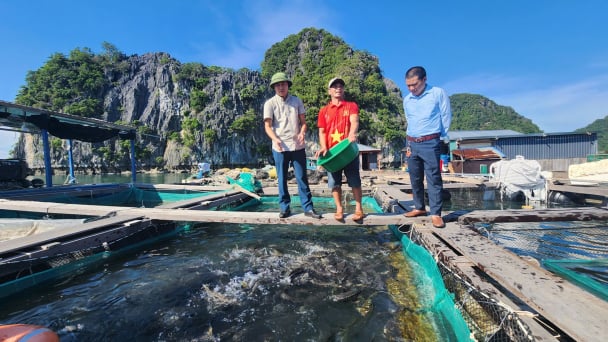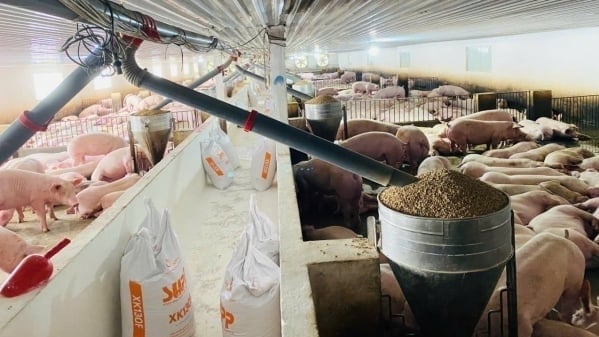September 6, 2025 | 10:50 GMT +7
September 6, 2025 | 10:50 GMT +7
Hotline: 0913.378.918
September 6, 2025 | 10:50 GMT +7
Hotline: 0913.378.918
According to the Department of Irrigation Works Management and Construction under the Ministry of Agriculture and Environment, the mindset of water security was established in the early 2000s. Faced with domestic and production water shortages, particularly during the dry season, the Party Central Committee, the Politburo, and the National Assembly directed the construction of large reservoirs across regions. These reservoirs lay the groundwork for regional economic development not only for agriculture but also for multiple other purposes.
However, mobilizing preferential ODA funds for dam and reservoir construction proved nearly impossible and unfeasible. International donors and financial institutions remained hesitant, while enterprises and corporations were unable or unwilling to invest. As a result, the government bond program was launched to generate sufficient resources for building large-scale reservoirs.

The Krong Buk Ha reservoir in Ea Phe commune, Krong Pak district, began construction in December 2005, with a total investment of over VND 2.081 trillion financed through government bonds, under the management of Irrigation Construction Investment Management Board No. 8. Photo: DT.
A series of Vietnam's major reservoir projects were researched and developed, including Cua Dat reservoir (Thanh Hoa), Ta Trach reservoir (Hue), Nuoc Trong reservoir (Quang Ngai), Krong Buk Ha, Ia Mor, and Ia Mlah reservoirs in the Central Highlands, Phuoc Hoa and Song Ray irrigation systems, and many other auxiliary works.
Since 2016, the Party and the State have continued to prioritize agricultural infrastructure with a larger share of resources, affirming the agricultural sector's importance in the nation's economic development. Using medium-term public investment from the state budget, new multipurpose irrigation projects have been built.
A typical example is the Ban Lai reservoir, constructed on the Ky Cung River about 40 km from the center of Lang Son province, with a capacity of over 164 million m³. The reservoir not only controls Xiao-man and early floods and mitigates peak floods for the former Lang Son city and its surrounding areas but also irrigates over 2,000 ha of agricultural land, supplies domestic water for 122,000 people, and provides nearly 35,500 m³ of water per day for industrial use. Earlier, the People's Committee of the former Loc Binh district planned 1,000 ha across the communes of San Vien, Khuat Xa, Tu Doan, and Tinh Bac (former administrative units) surrounding the reservoir and downstream area to attract ecotourism investment.
Another example is Song Luy reservoir, located in Bac Binh district, former Binh Thuan province. Construction began in late September 2019, and water storage started by the end of 2020. Once completed, the project will irrigate 24,200 ha of farmland, generate hydropower, and mitigate downstream floods.
In the Central Highlands, although the Ea H'leo reservoir (Dak Lak province) has a modest designed capacity of 25.51 million m³, smaller than the major agricultural irrigation systems built in the 2016-2021 period, it stands out for its beautiful design. The main concrete dam stretches 312 m with a maximum height of 59 m, flanked by two concrete dikes on the left and right abutments. The work management area is designed with lush greenery and beautiful flower gardens, creating a scenic and idyllic space.

Ea H'leo 1 reservoir, with its picturesque landscape, is promised to become a tourist destination in Dak Lak. Photo: DT.
To facilitate sightseeing and promote tourism, the project has constructed a local road around the reservoir. The locality has added Ea H'leo 1 reservoir into the provincial tourism plan for 2021–2030, with a vision to 2045, emphasizing the development of effective management solutions, preservation, and promotion of traditional local festivals linked to eco-tourism at the reservoir. Community involvement is also encouraged to protect the surrounding ecological environment.
Dong Mit reservoir is another project noted for its beautiful design and scenery. Construction began in late February 2019, with water storage starting in January 2021. The reservoir is surrounded by protection and acacia forests. The green forest blends with the blue waters of the An Lao River stored in the reservoir, creating a poetic ecological space, thereby becoming a new tourist destination for local residents.
The reservoir has a catchment area of 163.3 km² and a designed capacity of nearly 90 million m³. Once put into operation, Dong Mit reservoir and the saltwater dam on the Lai Giang River will be interconnected, ensuring domestic water supply for 276,000 people and irrigation for 6,742 ha of agricultural land in the downstream areas of An Lao, Hoai An, and Hoai Nhon town as well as northern areas of Phu My district (former administrative units) in Binh Dinh province, before merging with Gia Lai province (forming the new Gia Lai province).
Over the past decade, a series of major irrigation works were built, demonstrating remarkable advances in engineering and construction technology. Notable among them is the Ngoi Gianh reservoir, recognized by the Ministry of Agriculture and Rural Development (now the Ministry of Agriculture and Environment) as "the fastest-constructed reservoir in Vietnam." With a designed capacity of nearly 37 million m³, the main dam is a gravity concrete structure over 240 m long and more than 70 m high, with a total investment of VND 1,279 billion.

Ngoi Gianh reservoir in Phu Tho province. Photo: DT.
The reservoir serves as a source for small- and medium-scale reservoirs in the region, helping to prevent and mitigate flash floods and stabilize livelihoods for 35 disadvantaged communes in the former districts of Yen Lap, Cam The, and Thanh Ba in Phu Tho province. After nearly three years of intensive construction, on November 30, 2021, the reservoir was ready for impoundment. Its open, majestic location also holds the potential to become a tourism, camping, and "check-in" destination for young visitors.
Tan My reservoir (formerly Ninh Thuan, now Khanh Hoa province) is Vietnam’s first project to use a high-pressure pipeline system for downstream irrigation. The pipeline, with a diameter of up to 2 m and a total length of 30,000 m, can withstand extremely high pressure, making it the most modern water pipeline system in Vietnam to date. This pipeline solution sets a model for automated, modernized operation management, shifting the approach to water security (transferring water between basins) from canal systems to pipeline networks. Such closed pipelines are particularly suited for high-tech agriculture, enhancing added value.

Song Cai dam and Tan My water transfer system can convey water to Ba Rau, Song Trau, and Ong Kinh reservoirs through high-pressure steel pipelines. Photo: DT.
This year, a major irrigation project expected to be inaugurated in celebration of the 80th anniversary of the Agriculture and Environment sector is the Ban Mong reservoir. As the largest irrigation project in Nghe An, it is located on the upper reaches of the Hieu River in Quy Hop district, with a total investment exceeding VND 3,700 billion. A notable feature of the project is the first-time experimental use of fly ash in large-mass concrete during construction, which proved successful. The reservoir’s main functions include supplying irrigation water for 18,871 ha of farmland along the Hieu River, providing around 22 m³/s to the Ca River during the dry season, and generating hydropower with an installed capacity of 42 MW.
When discussing the maturity of river irrigation construction in Vietnam, the country's "largest super sluices," Cai Lon–Cai Be, stand out. Cai Lon is 455 m long with 11 bays, each 40 m wide. Cai Be has 2 bays, each 35 m wide, with a 15-meter-wide lock. The Xeo Ro sluice is 42 m wide, forming a lock chamber. Two-lane bridges over the sluices connect to National Highway 61 via a 5.8 km-long dike.

The Cai Lon–Cai Be sluices are considered "Vietnam's largest super irrigation sluices." Photo: DT.
The project is the largest saltwater-freshwater control system in Southeast Asia, enabling stable and sustainable production for ecosystem-based farming models (freshwater, saline-brackish, and fresh-brackish) across more than 384 ha in the former provinces of Kien Giang, Hau Giang, Ca Mau, and Bac Lieu. It also plays a key role in disaster prevention, working with dikes and coastal sluices in the western region to form a protective barrier against sea-level rise and storm surges.
In addition, the Mekong Delta has the Ninh Quoi lock sluice, Vietnam's largest lock. Located on the Quan Lo–Phung Hiep canal in Hong Dan district, Bac Lieu province, it was started in November 2018 and inaugurated on October 11, 2020. The structure has two open sluices at either end and a 150 m-long lock chamber over 31 m wide, with architectural design harmonized with the surrounding landscape.

The Ninh Quoi lock is an irrigation structure with the largest lock in Vietnam. Photo: DT.
The lock regulates water for over 80,000 ha of rice-shrimp farming, contributing to the completion of new rural development in Phuoc Long and Hong Dan districts of the former Bac Lieu province. It is a key project in the Mekong Delta irrigation plan with a vision to 2050, designed to proactively respond to climate change, sea-level rise, salinity control, and regional transportation development.
According to the Department of Irrigation Works Management and Construction, Vietnam currently has 904 medium- and large-scale irrigation systems serving areas of 200 ha or more, including 110 systems with a scale of over 2,000 ha, 6,336 reservoirs, nearly 16,000 weirs, over 19,400 large pumping stations, 5,500 major sluices, and more than 291,000 km of canals.
These irrigation systems supply water to approximately 4.28 million ha of the 6.25 million ha of agricultural land requiring irrigation (68.48%). Under normal weather conditions, Northern Mountainous, Central, and Central Highlands irrigation works achieve 75% of designed capacity, while the Red River Delta and Mekong Delta exceed 90%.
Annually, irrigation supports about 7.26 million ha of rice (95% of planted area), nearly 0.29 million ha of advanced, water-saving crops out of 2.4 million ha, 686,600 ha of aquaculture, and roughly 6.5 billion m³ of domestic and industrial water. The system also ensures flood control, urban and residential protection, and reclamation of 1.6 million ha of acidic and saline land. Irrigation contributes to annual production of over 43 million tons of rice, 1.3 million tons of coffee, 1.5 million tons of tea, 16 million tons of vegetables, more than 8.5 million tons of fruits, and 7.56 million tons of aquaculture products.
The World Bank has repeatedly assessed Vietnam as having one of the world’s most and best irrigation infrastructures. With around 290,000 pumping stations of various sizes and 170,000 canal structures spanning millions of kilometers, the reservoir network and water regulation system provide a solid foundation for agricultural restructuring, ensuring that Vietnam’s agriculture has sufficient water for proactive production.
Translated by Thu Huyen
/2025/09/05/3330-6-152855_681.jpg)
(VAN) From thatched barns to high-tech farms, Vietnam's livestock industry has undergone a strong transformation over the past 80 years, firmly stepping into the orbit of the circular economy.

(VAN) AI technology for rice seed quality control has already been successfully applied in Thailand and India. In Vietnam, this technology promises innovation, but challenges remain regarding input data.

(VAN) The National Agricultural Extension and Quang Ninh are affirming their important role in developing marine aquaculture towards high technology, sustainability, market orientation.
/2025/09/03/1620-3-160956_644.jpg)
(VAN) Under global requirements, Vietnam is urgently finalizing measurement tools, ensuring data transparency, and completing a legal framework to transform its forest potential into a sustainable resource.

(VAN) Amid the African swine fever ‘storm’, large-scale livestock farms in Lao Cai remain safe thanks to strict biosecurity practices.
/2025/09/02/2302-5-070350_276.jpg)
(VAN) Prof. Dr. Pham Hong Giang, former Deputy Minister of Agriculture and Rural Development, shared his unforgettable memories of constructing large reservoirs and dams in Central Vietnam.